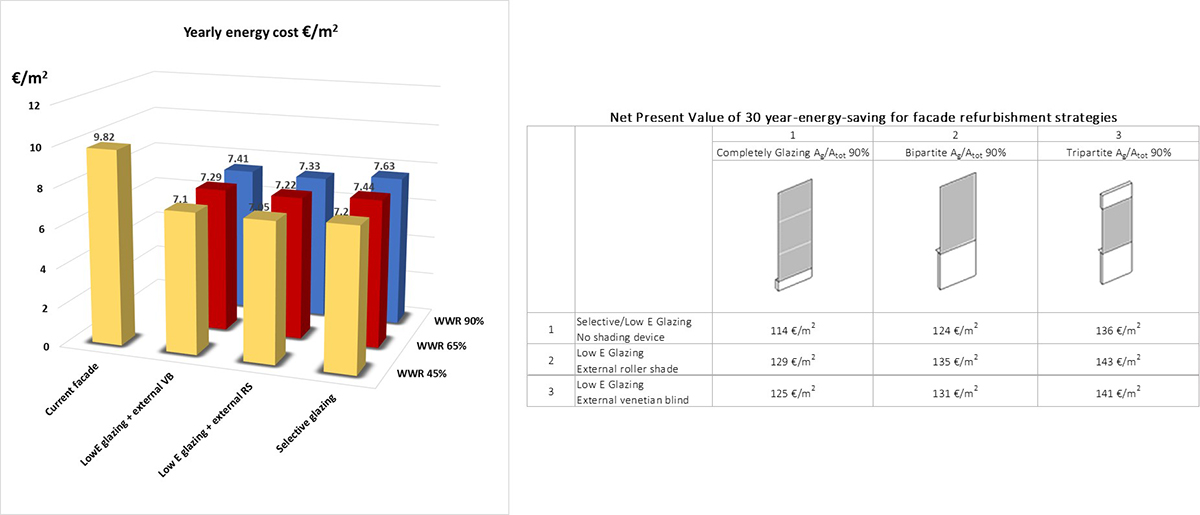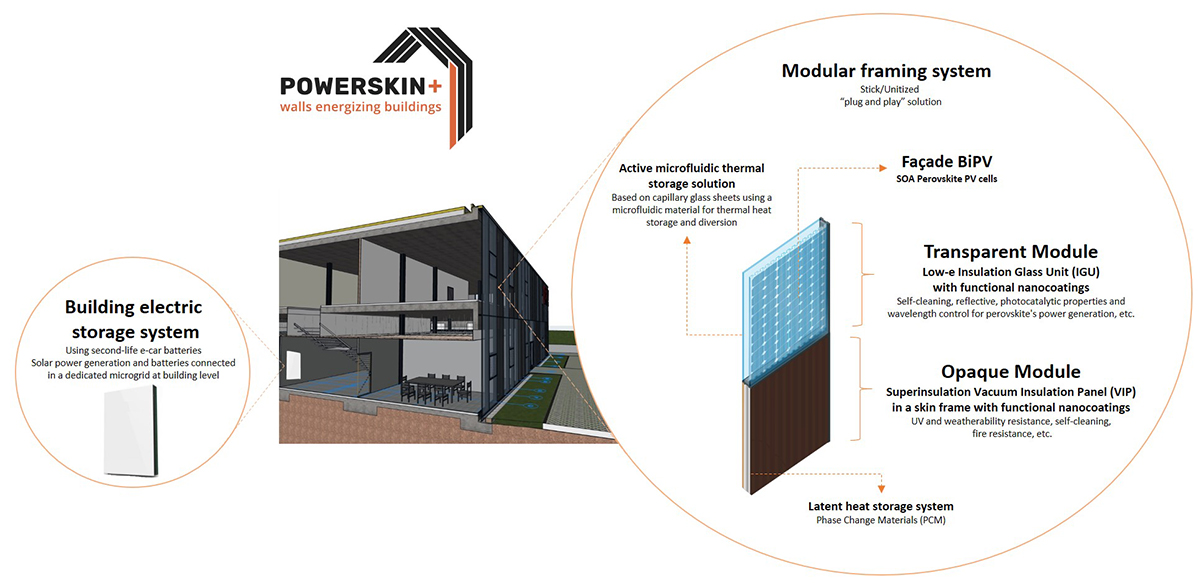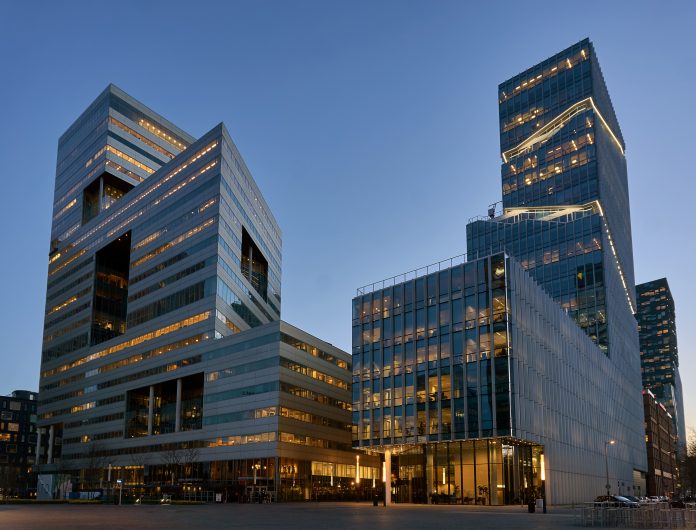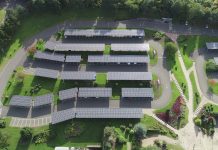Here we learn about Powerskin+, advanced next-generation multifunctional building skins for energy and carbon-neutral non-residential buildings
Fabio Favoino1, Stefano Fantucci1, Shahaboddin Resalati2, Mizi Fan3, Jorge Corker4,*
1 Technology Energy Building Environment research group, Energy Department, Politecnico di Torino, C.so Duca degli Abruzzi, 24, 10129, Torino, Italy
2 Oxford Brookes University, Headington Campus, OX3 0BP, Oxford, UK
3 Department of Civil and Environmental Engineering, Brunel University London, Uxbridge, UB8 3PH, United Kingdom
4 IPN- Instituto Pedro Nunes, Rua Pedro Nunes, 3030-199, Coimbra, Portugal, email: jcorker@ipn.pt * corresponding author
The building sector is targeting increasingly stringent carbon emission reduction measures throughout its entire life cycle, intending to minimise its potential impact on climate change. Non-residential buildings account for 25% of the European building stock and are responsible for more than 60% of all building energy end-uses. The energy and carbon savings that can be derived from this sector are therefore considerable. Adopting a ‘fabric-first’ approach, including improving U-values and air-tightness, is a first important step towards achieving the required energy savings. As a result, technologies improving insulation performance without reducing the internal living areas can yield promising results in terms of energy, space-saving and, thus, a return of the investment shorter than a typical façade service life (25-30 years). This is particularly significant in heating-dominated locations, where high rental values can outweigh the higher capital costs, as demonstrated while using Vacuum Insulation Panels (VIP) as an energy-efficiency solution.
Tertiary buildings pose additional challenges to the facade, including high occupant comfort requirements, high solar and internal gains, due to highly glazed façades and densely occupied spaces. Cost-effective and energy-efficient façade solutions are therefore proven to be more challenging to achieve, as the building envelope may have a lower impact on total energy uses (including heating, cooling and lighting) compared to occupant environmental comfort. This can negatively impact the cost payback within the façade service life, as the reduction of energy cost alone is not able to offset the cost of the façade refurbishment (Figure 1 shows this for a façade refurbishment of a tertiary building in Torino, Italy).

In addition, embodied energy is being gradually regulated across Europe. Some examples are given by the current French and Belgian legislation, which are moving to mandate the consideration of embodied energy and the disclosure of Environmental Product Declarations for construction materials. For any energy payback analysis to be truly representative of a sustainable approach, a combined operational and embodied energy analysis needs to be adopted. Whilst considering incremental increases in building envelope properties for reducing the operational energy of buildings, factoring embodied energy into a combined analysis tends to limit the minimum energy levels that can be achieved. A combined method limits the fabric-first approach to optimum U-value ranks, beyond which embodied energy investment outweighs operational energy savings.
Future policy developments demand novel façade solutions that can cost-effectively optimise better energy performance and occupant comfort with lower embodied energy investments. Achieving strict energy efficiency standards requires adopting advanced and high-performance technologies such as off-site manufacturing, renewable energy conversion technologies, and dynamic and smart materials. Nevertheless, current high-performance façade systems, such as Double Skin and Advanced Integrated Façades, have been associated with several drawbacks, including i) low thermal inertia that creates a negative impact on heat fluxes exchanged between the outdoor and indoor, ii) excessive transparent area and, iii) heavily dependent on modular design implementation. Within this context, next-generation façade solutions are required to go beyond the “energy conservation approach”, by considering not only energy but also carbon neutrality, occupant comfort and space value.
POWERSKIN PLUS
POWERSKIN PLUS is developing and scaling-up eco-innovative and cost-effective curtain wall façade solutions, both for new and renovated buildings. Its multifunctional façade systems incorporate the latest materials science and renewable energy technological developments, offering a unique solution to meet the requirements of nearly zero-energy buildings(nZEB) and Positive Energy Buildings (PEB). The system currently being developed aims at providing the market with effective and high performance “plug-and-play” modular kits, covering thermal insulation, energy harvesting and energy storing, compatible with high-throughput window/façade design and assembly technologies (Figure 2).

Highly focused on the renovation market and by following the systematic and in-depth assessment of relevant technical parameters, POWERSKIN PLUS sets out a comprehensive work programme, covering an extensive list of activities, from lab testing to system design prototyping. The development includes several breakthrough features based on nano-formulated VIP, phase change materials (PCM), ground-breaking flexible thin perovskite solar cells and multifunctional nano-enabled coatings. The full POWERSKIN PLUS portfolio will comprise prefabricated and ‘easy-to-install’ modular glazing and opaque elements, sustainable eco-designed connecting framings, and a dedicated large capacity electric building storage system driven from second-life electric vehicle Li-ion batteries. This approach will benefit from the smart integration of highly insulative climatic control panels, with renewable on-site energy generation and storage components, along with dynamic and passive elements capable of minimising energy demand and maximising indoor environmental quality, all delivered by a single full combined solution.
Starting from TRL5 technology, the ultimate objective of the 4-year project is to generate a set of POWERSKIN PLUS hybrid-enabled system prototypes, and test them in an operational environment (TRL7) in Portugal, Slovenia and the Czech Republic, treading the path for future exploitation and supporting the most desired EU transition to plus energy and carbon-neutral building standards.
POWERSKIN PLUS – Highly advanced modular integration of insulation, energising and storage systems for non-residential buildings.
This project has received funding from the European Union’s Horizon 2020 research and innovation programme under grant agreement No 869898.
Please note: This is a commercial profile











